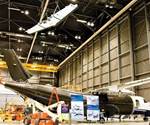Performance requirements: CAI vs. OHC
John Russell, who manages nonautoclave research programs for the Air Force Research Laboratory (AFRL, Wright-Patterson AFB, Ohio), recently threw down the gauntlet at the Fall SAMPE conference in Salt Lake City, Utah: “Give us a 25 percent improvement in notch properties with no microcracking in high-modulus fibers.” While OOA prepreg suppliers can’t do much about fiber microcracking, Advanced Composites Group (ACG, Tulsa, Okla.) already has announced that its XMTM47 material will be commercial by next year, designed for 120°C/248°F service with the increased notched performance requested.
John Russell, who manages nonautoclave research programs for the Air Force Research Laboratory (AFRL, Wright-Patterson AFB, Ohio), recently threw down the gauntlet at the Fall SAMPE conference in Salt Lake City, Utah: “Give us a 25 percent improvement in notch properties with no microcracking in high-modulus fibers.” While OOA prepreg suppliers can’t do much about fiber microcracking, Advanced Composites Group (ACG, Tulsa, Okla.) already has announced that its XMTM47 material will be commercial by next year, designed for 120°C/248°F service with the increased notched performance requested. Notched compressive strength is commonly measured by the open-hole compression (OHC) test. ACG’s XMTM47 material is targeted for an OHC of 43 ksi 220°F wet versus ≈35 ksi for a tougher system such as MTM45-1.
However, according to Yeow Ng, associate director of the National Center for Advanced Materials Performance (NCAMP, Wichita, Kan.), the compression-after-impact performance (CAI, which indicates damage tolerance) of OOA prepregs will have to increase if they are to fly on commercial aircraft. In a recent Flight Daily News article by Stephen Trimble, Ng noted, ”[MTM45-1] falls short of qualifying for the strength tolerances demanded by regulators for commercial airliners. The 787 structure’s compression after impact [CAI] strength level measures in the mid-40s [ksi], but MTM45-1 falls somewhere in the mid-30 [ksi] range.”
Chris Ridgard, ACG’s VP of research and technology, responds that numerous structures that fly on Hawker Beech, Embraer, Gulfstream and Bombardier aircraft were made from autoclave-cured Hexcel 8552 (CAI ≈30 ksi) and Cytec 977-2 (CAI ≈37ksi) prepregs. He also notes that CYCOM 5320, in qualification for the Learjet 85, has a published CAI of 26.5 ksi. “This debate has existed long before OOA became a trend, beginning with autoclave materials in the 1970s and different design philosophies based on specific application needs.” Ridgard, once a structural engineer at British Aerospace (Manchester, U.K.), explains that military applications are typically driven by notched strains, “which provides for the presence of a hole anywhere on the structure, affording a degree of allowance for battle damage and bolted repairs.” Thus, military aircraft have tended to use less toughened resin systems with higher OHC values. Ridgard continues, “For large commercial airplanes with large structures containing relatively few fasteners, the preference of some airframe manufacturers has been to use highly toughened resin systems with very high CAI values and high damaged strains to failure.”
ACG says that it will develop an OOA system with CAI in the high 40s, a highly toughened system, for the commercial aircraft community. Cytec says this will be its next priority as well. When asked whether OHC or CAI drives Aurora Flight Sciences’ (Columbus, Miss.) UAV designs, Aurora structural engineer Ed Wen responds, “Both.” That lines up with the view taken by The Boeing Co.’s (St. Louis, Mo.) Gail Hahn: “We all know there are trade-offs with different material systems, so a range of OOA prepregs will be needed to meet different design requirements.”
Related Content
-
PEEK vs. PEKK vs. PAEK and continuous compression molding
Suppliers of thermoplastics and carbon fiber chime in regarding PEEK vs. PEKK, and now PAEK, as well as in-situ consolidation — the supply chain for thermoplastic tape composites continues to evolve.
-
TU Munich develops cuboidal conformable tanks using carbon fiber composites for increased hydrogen storage
Flat tank enabling standard platform for BEV and FCEV uses thermoplastic and thermoset composites, overwrapped skeleton design in pursuit of 25% more H2 storage.
-
Plant tour: Teijin Carbon America Inc., Greenwood, S.C., U.S.
In 2018, Teijin broke ground on a facility that is reportedly the largest capacity carbon fiber line currently in existence. The line has been fully functional for nearly two years and has plenty of room for expansion.













